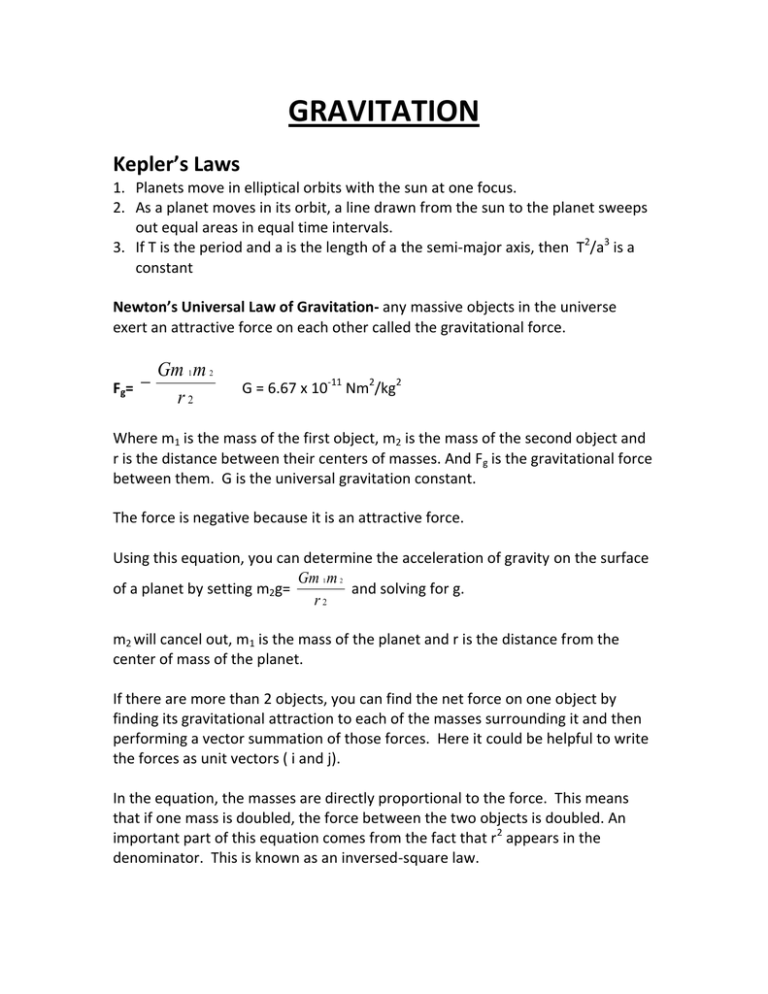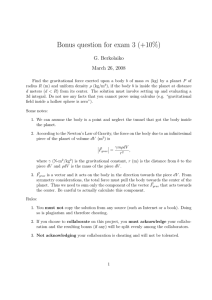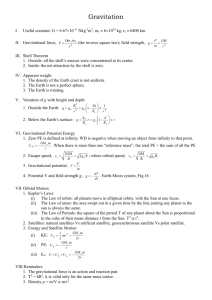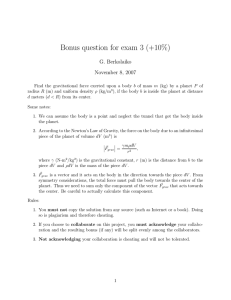Gravitation
advertisement

GRAVITATION Kepler’s Laws 1. Planets move in elliptical orbits with the sun at one focus. 2. As a planet moves in its orbit, a line drawn from the sun to the planet sweeps out equal areas in equal time intervals. 3. If T is the period and a is the length of a the semi-major axis, then T2/a3 is a constant Newton’s Universal Law of Gravitation- any massive objects in the universe exert an attractive force on each other called the gravitational force. F g= Gm 1 m 2 r2 G = 6.67 x 10-11 Nm2/kg2 Where m1 is the mass of the first object, m2 is the mass of the second object and r is the distance between their centers of masses. And Fg is the gravitational force between them. G is the universal gravitation constant. The force is negative because it is an attractive force. Using this equation, you can determine the acceleration of gravity on the surface Gm 1 m 2 of a planet by setting m2g= and solving for g. r2 m2 will cancel out, m1 is the mass of the planet and r is the distance from the center of mass of the planet. If there are more than 2 objects, you can find the net force on one object by finding its gravitational attraction to each of the masses surrounding it and then performing a vector summation of those forces. Here it could be helpful to write the forces as unit vectors ( i and j). In the equation, the masses are directly proportional to the force. This means that if one mass is doubled, the force between the two objects is doubled. An important part of this equation comes from the fact that r 2 appears in the denominator. This is known as an inversed-square law. Circular Orbits If we can assume a circular orbit for a satellite in orbit around a planet (or a planet around a star) we know that the gravitational force between them is causing the circular motion. In other words, centripetal force = gravitational force. Fcentripetal = Fgravitation m1v2/r= Gm 1 m 2 r2 where m1 is the mass of the satellite in orbit and m2 is the mass of the planet, and r is the distance between the objects’ centers. Using these equations, you can obviously solve for any of the variables included, but you can also solve for the satellite’s period. Period, T, is the time it takes for the satellite to complete one full revolution. T= 2 r v Gravitational Fields Spherical Shell – When you are outside of the shell, it can be treated as if all the mass is at the center, a distance r away. When you are inside a spherical shell, you experience no net gravitational force. g(r) = 0 Fg = 0 for r< R g(r) = Gm r2 Fg = Gm 1 m 2 r2 for r R Gravitational Force vs. Distance for A Spherical Shell r Fgravitation R Solid Sphere – When you are outside of the sphere, it can be treated as if all the mass is at the center, a distance r away. When you are inside a solid sphere, the mass in the shell above you exerts no net gravitational force (like above). However, the mass in the sphere “below” you does exert a force. So when you are a distance r away from the center, you experience a gravitational force due to the mass and radius of the mass “beneath” you acting as its own planet. g(r) = Gm R3 g(r) = Gm r2 r Fg = Fg = Gm 1 m 2 r R3 Gm 1 m 2 r2 for r< R for r R The equations for r< R come from a more general equation Fg= Gm 1 m in side r2 In this space, solve for Fg = Gm 1 m 2 r R3 using Newton’s Universal Law of gravitation. Hint: use density to put minside in terms of known variables such as the mass of the planet and the radius of the planet. Gravitational Force vs. Distance for A Solid Sphere Fgravitation R r Gravitational Potential Energy U = - - U=- Gm 1 m 2 dr r2 Gm 1 m 2 r This means that the gravitational potential energy is negative at the surface of the planet and becomes closer and closer to zero until you are an infinite distance away, in which case the gravitational potential energy is zero. You will want to use this equation instead of U= mgh when you are dealing with a problem where the projectile is far from the surface of the Earth (when g is no longer 9.8 m/s2). Gravitational potential energy is also helpful when solving problems involving the conservation of mechanical energy, such as when a projectile is launched away from the surface of the Earth or when a projectile in space comes towards the Earth. Total mechanical energy E= Uo + Ko Uo + Ko = Uf + Kf Instead of using mgh here, make sure you use the new form. - Gm 1 m 2 Gm 1 m 2 + ½ m vo2 = + ½ m v f2 rf ro (make sure that you use the distance from their center of masses for r). Escape Speed- the minimum speed required to escape from the Earth’s gravity. If Ko > Uo then it will escape (unbounded) If Ko < Uo then it won’t escape (bounded) So if E = Ko + Uo 0, than the objects can escape! - Gm 1 m 2 + ½ m vo2 0 ro then Gm 1 m 2 = ½ m vo2 ro so vescape = 2Gmearth R



